LSME603 - Evaluating Human Fallibility and Just Culture in Risk
VerifiedAdded on 2023/06/14
|10
|2511
|385
Essay
AI Summary
This essay evaluates the applicability of human fallibility in workplace risk situations and applies the concept of a 'just' culture to foster openness and accountability. It differentiates between human errors, at-risk behavior, and reckless behavior, emphasizing the importance of understanding the systemic causes of errors rather than solely blaming individuals. The essay also explores active and latent failures, various types of human errors (slips, lapses, mistakes, and violations), and the benefits of implementing a just culture, including improved safety, learning, and trust. The report concludes by recommending the development of clear procedures, regular training, systematic monitoring, and a commitment to a learning culture to enhance risk management and safety within the organization. Desklib offers a wealth of study resources, including past papers and solved assignments, to support students in mastering these concepts.
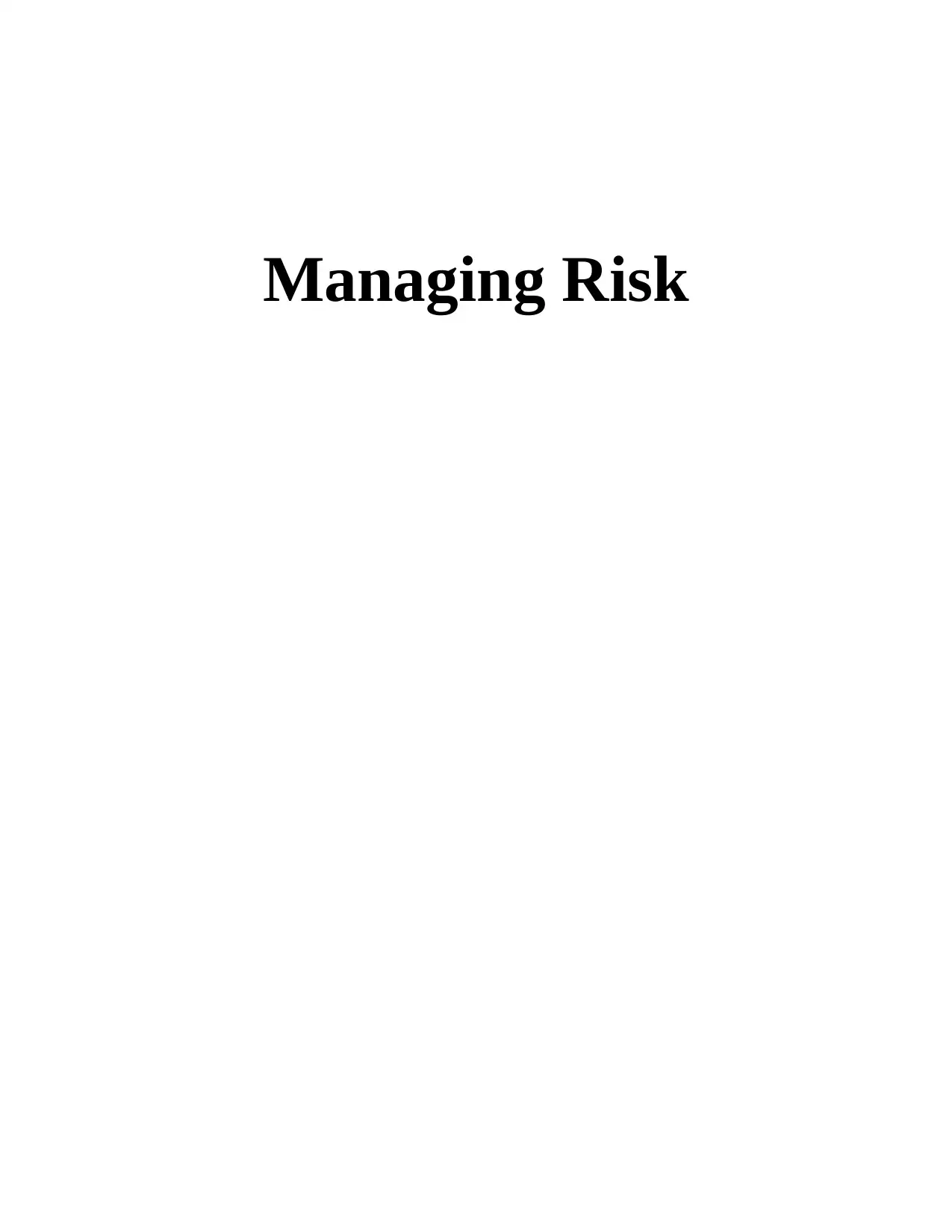
Managing Risk
Paraphrase This Document
Need a fresh take? Get an instant paraphrase of this document with our AI Paraphraser
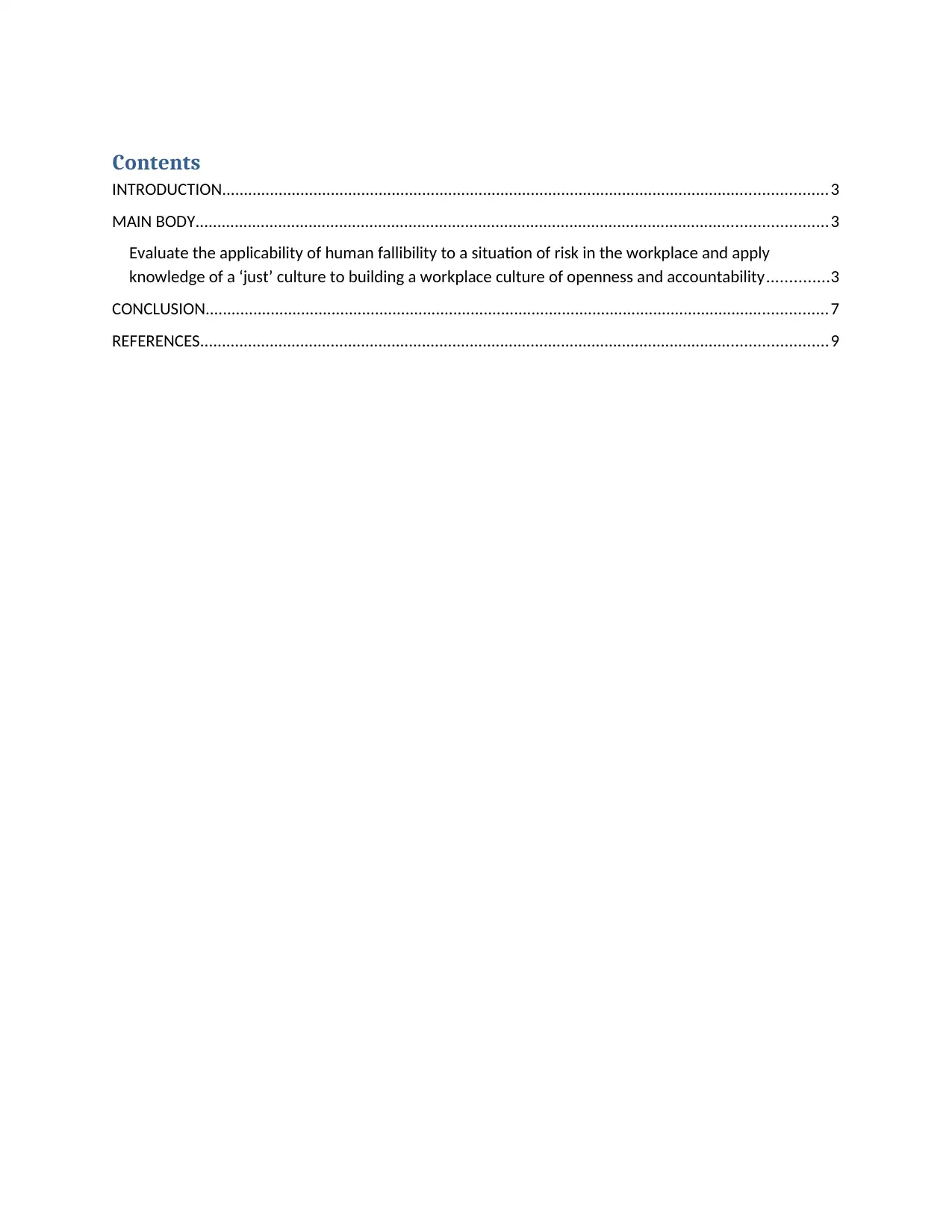
Contents
INTRODUCTION...........................................................................................................................................3
MAIN BODY.................................................................................................................................................3
Evaluate the applicability of human fallibility to a situation of risk in the workplace and apply
knowledge of a ‘just’ culture to building a workplace culture of openness and accountability..............3
CONCLUSION...............................................................................................................................................7
REFERENCES................................................................................................................................................9
INTRODUCTION...........................................................................................................................................3
MAIN BODY.................................................................................................................................................3
Evaluate the applicability of human fallibility to a situation of risk in the workplace and apply
knowledge of a ‘just’ culture to building a workplace culture of openness and accountability..............3
CONCLUSION...............................................................................................................................................7
REFERENCES................................................................................................................................................9
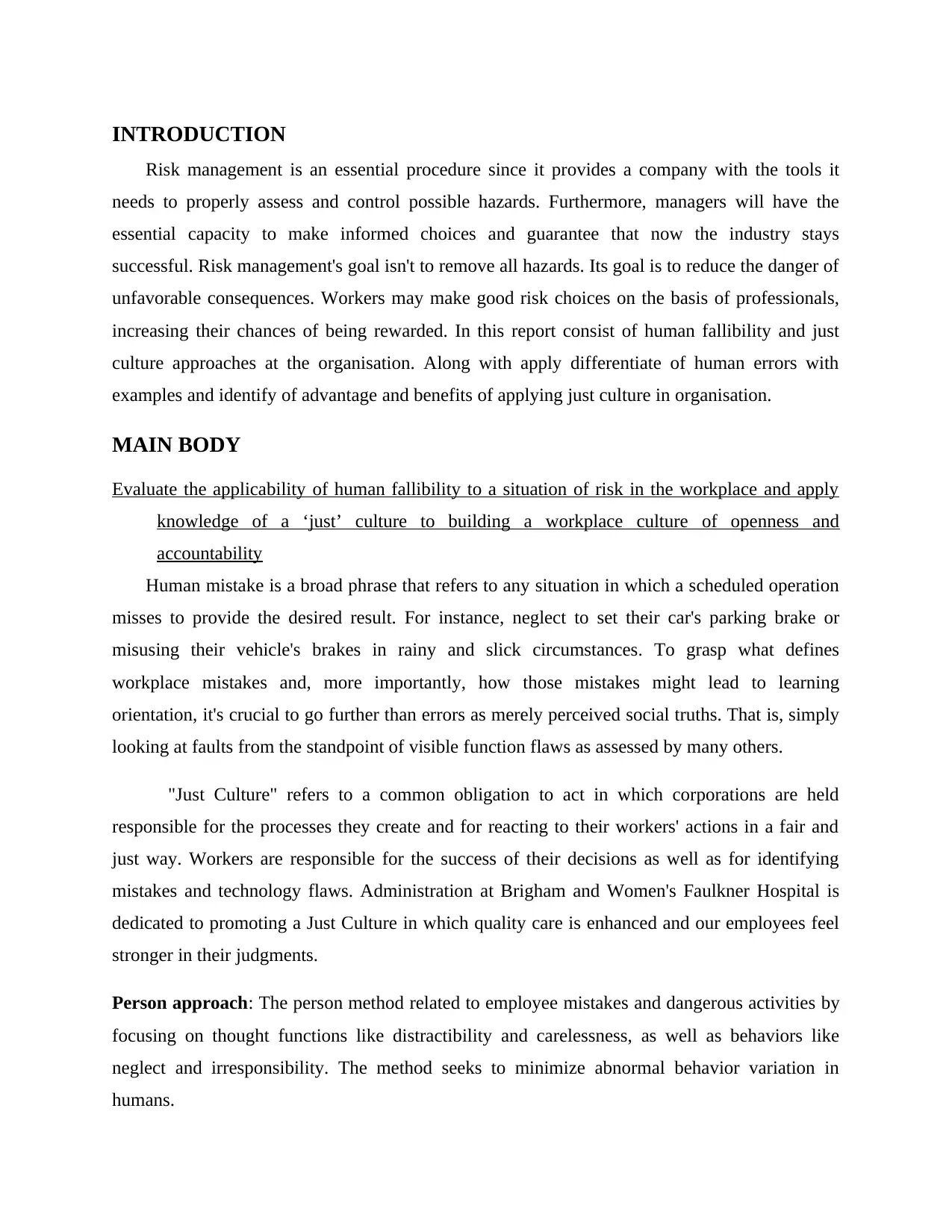
INTRODUCTION
Risk management is an essential procedure since it provides a company with the tools it
needs to properly assess and control possible hazards. Furthermore, managers will have the
essential capacity to make informed choices and guarantee that now the industry stays
successful. Risk management's goal isn't to remove all hazards. Its goal is to reduce the danger of
unfavorable consequences. Workers may make good risk choices on the basis of professionals,
increasing their chances of being rewarded. In this report consist of human fallibility and just
culture approaches at the organisation. Along with apply differentiate of human errors with
examples and identify of advantage and benefits of applying just culture in organisation.
MAIN BODY
Evaluate the applicability of human fallibility to a situation of risk in the workplace and apply
knowledge of a ‘just’ culture to building a workplace culture of openness and
accountability
Human mistake is a broad phrase that refers to any situation in which a scheduled operation
misses to provide the desired result. For instance, neglect to set their car's parking brake or
misusing their vehicle's brakes in rainy and slick circumstances. To grasp what defines
workplace mistakes and, more importantly, how those mistakes might lead to learning
orientation, it's crucial to go further than errors as merely perceived social truths. That is, simply
looking at faults from the standpoint of visible function flaws as assessed by many others.
"Just Culture" refers to a common obligation to act in which corporations are held
responsible for the processes they create and for reacting to their workers' actions in a fair and
just way. Workers are responsible for the success of their decisions as well as for identifying
mistakes and technology flaws. Administration at Brigham and Women's Faulkner Hospital is
dedicated to promoting a Just Culture in which quality care is enhanced and our employees feel
stronger in their judgments.
Person approach: The person method related to employee mistakes and dangerous activities by
focusing on thought functions like distractibility and carelessness, as well as behaviors like
neglect and irresponsibility. The method seeks to minimize abnormal behavior variation in
humans.
Risk management is an essential procedure since it provides a company with the tools it
needs to properly assess and control possible hazards. Furthermore, managers will have the
essential capacity to make informed choices and guarantee that now the industry stays
successful. Risk management's goal isn't to remove all hazards. Its goal is to reduce the danger of
unfavorable consequences. Workers may make good risk choices on the basis of professionals,
increasing their chances of being rewarded. In this report consist of human fallibility and just
culture approaches at the organisation. Along with apply differentiate of human errors with
examples and identify of advantage and benefits of applying just culture in organisation.
MAIN BODY
Evaluate the applicability of human fallibility to a situation of risk in the workplace and apply
knowledge of a ‘just’ culture to building a workplace culture of openness and
accountability
Human mistake is a broad phrase that refers to any situation in which a scheduled operation
misses to provide the desired result. For instance, neglect to set their car's parking brake or
misusing their vehicle's brakes in rainy and slick circumstances. To grasp what defines
workplace mistakes and, more importantly, how those mistakes might lead to learning
orientation, it's crucial to go further than errors as merely perceived social truths. That is, simply
looking at faults from the standpoint of visible function flaws as assessed by many others.
"Just Culture" refers to a common obligation to act in which corporations are held
responsible for the processes they create and for reacting to their workers' actions in a fair and
just way. Workers are responsible for the success of their decisions as well as for identifying
mistakes and technology flaws. Administration at Brigham and Women's Faulkner Hospital is
dedicated to promoting a Just Culture in which quality care is enhanced and our employees feel
stronger in their judgments.
Person approach: The person method related to employee mistakes and dangerous activities by
focusing on thought functions like distractibility and carelessness, as well as behaviors like
neglect and irresponsibility. The method seeks to minimize abnormal behavior variation in
humans.
⊘ This is a preview!⊘
Do you want full access?
Subscribe today to unlock all pages.

Trusted by 1+ million students worldwide
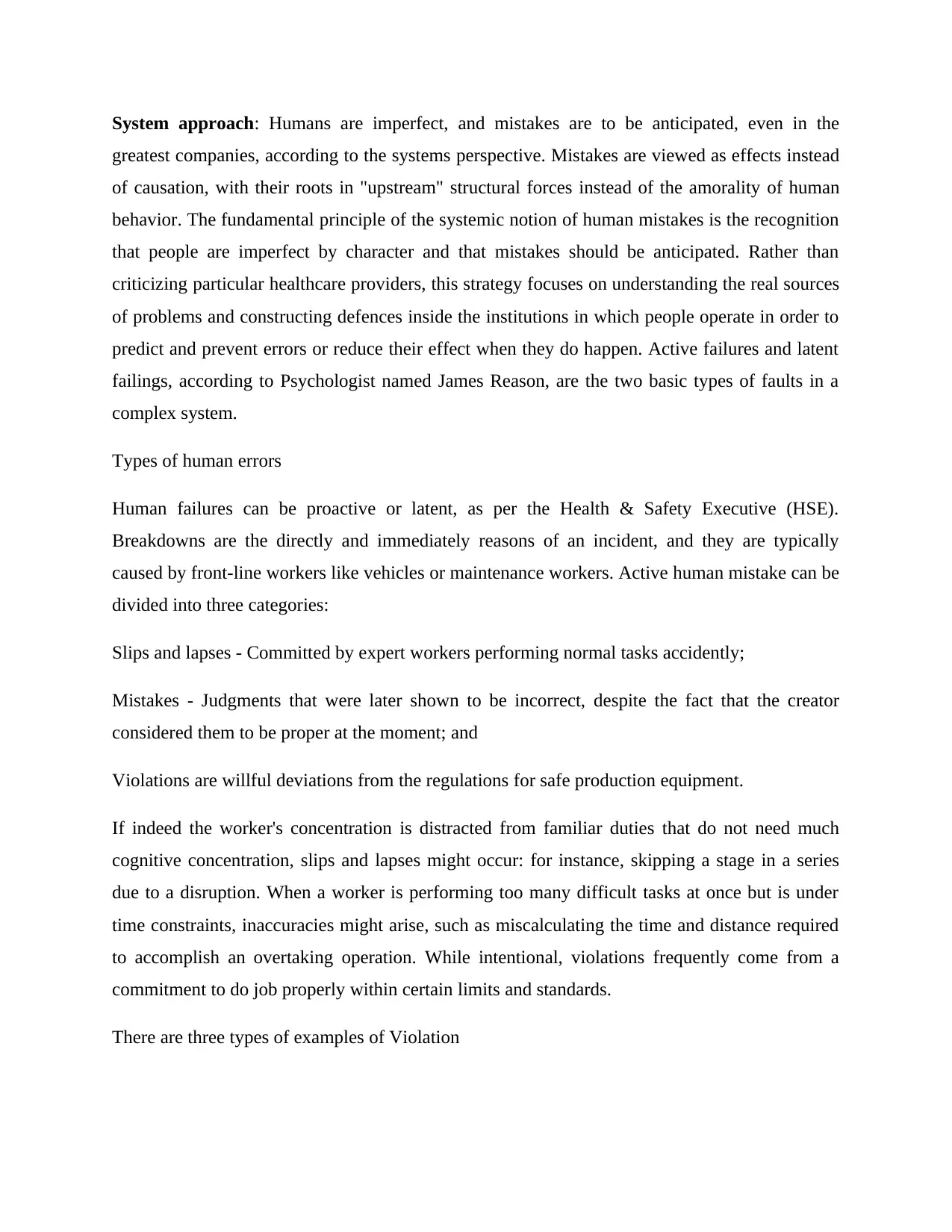
System approach: Humans are imperfect, and mistakes are to be anticipated, even in the
greatest companies, according to the systems perspective. Mistakes are viewed as effects instead
of causation, with their roots in "upstream" structural forces instead of the amorality of human
behavior. The fundamental principle of the systemic notion of human mistakes is the recognition
that people are imperfect by character and that mistakes should be anticipated. Rather than
criticizing particular healthcare providers, this strategy focuses on understanding the real sources
of problems and constructing defences inside the institutions in which people operate in order to
predict and prevent errors or reduce their effect when they do happen. Active failures and latent
failings, according to Psychologist named James Reason, are the two basic types of faults in a
complex system.
Types of human errors
Human failures can be proactive or latent, as per the Health & Safety Executive (HSE).
Breakdowns are the directly and immediately reasons of an incident, and they are typically
caused by front-line workers like vehicles or maintenance workers. Active human mistake can be
divided into three categories:
Slips and lapses - Committed by expert workers performing normal tasks accidently;
Mistakes - Judgments that were later shown to be incorrect, despite the fact that the creator
considered them to be proper at the moment; and
Violations are willful deviations from the regulations for safe production equipment.
If indeed the worker's concentration is distracted from familiar duties that do not need much
cognitive concentration, slips and lapses might occur: for instance, skipping a stage in a series
due to a disruption. When a worker is performing too many difficult tasks at once but is under
time constraints, inaccuracies might arise, such as miscalculating the time and distance required
to accomplish an overtaking operation. While intentional, violations frequently come from a
commitment to do job properly within certain limits and standards.
There are three types of examples of Violation
greatest companies, according to the systems perspective. Mistakes are viewed as effects instead
of causation, with their roots in "upstream" structural forces instead of the amorality of human
behavior. The fundamental principle of the systemic notion of human mistakes is the recognition
that people are imperfect by character and that mistakes should be anticipated. Rather than
criticizing particular healthcare providers, this strategy focuses on understanding the real sources
of problems and constructing defences inside the institutions in which people operate in order to
predict and prevent errors or reduce their effect when they do happen. Active failures and latent
failings, according to Psychologist named James Reason, are the two basic types of faults in a
complex system.
Types of human errors
Human failures can be proactive or latent, as per the Health & Safety Executive (HSE).
Breakdowns are the directly and immediately reasons of an incident, and they are typically
caused by front-line workers like vehicles or maintenance workers. Active human mistake can be
divided into three categories:
Slips and lapses - Committed by expert workers performing normal tasks accidently;
Mistakes - Judgments that were later shown to be incorrect, despite the fact that the creator
considered them to be proper at the moment; and
Violations are willful deviations from the regulations for safe production equipment.
If indeed the worker's concentration is distracted from familiar duties that do not need much
cognitive concentration, slips and lapses might occur: for instance, skipping a stage in a series
due to a disruption. When a worker is performing too many difficult tasks at once but is under
time constraints, inaccuracies might arise, such as miscalculating the time and distance required
to accomplish an overtaking operation. While intentional, violations frequently come from a
commitment to do job properly within certain limits and standards.
There are three types of examples of Violation
Paraphrase This Document
Need a fresh take? Get an instant paraphrase of this document with our AI Paraphraser
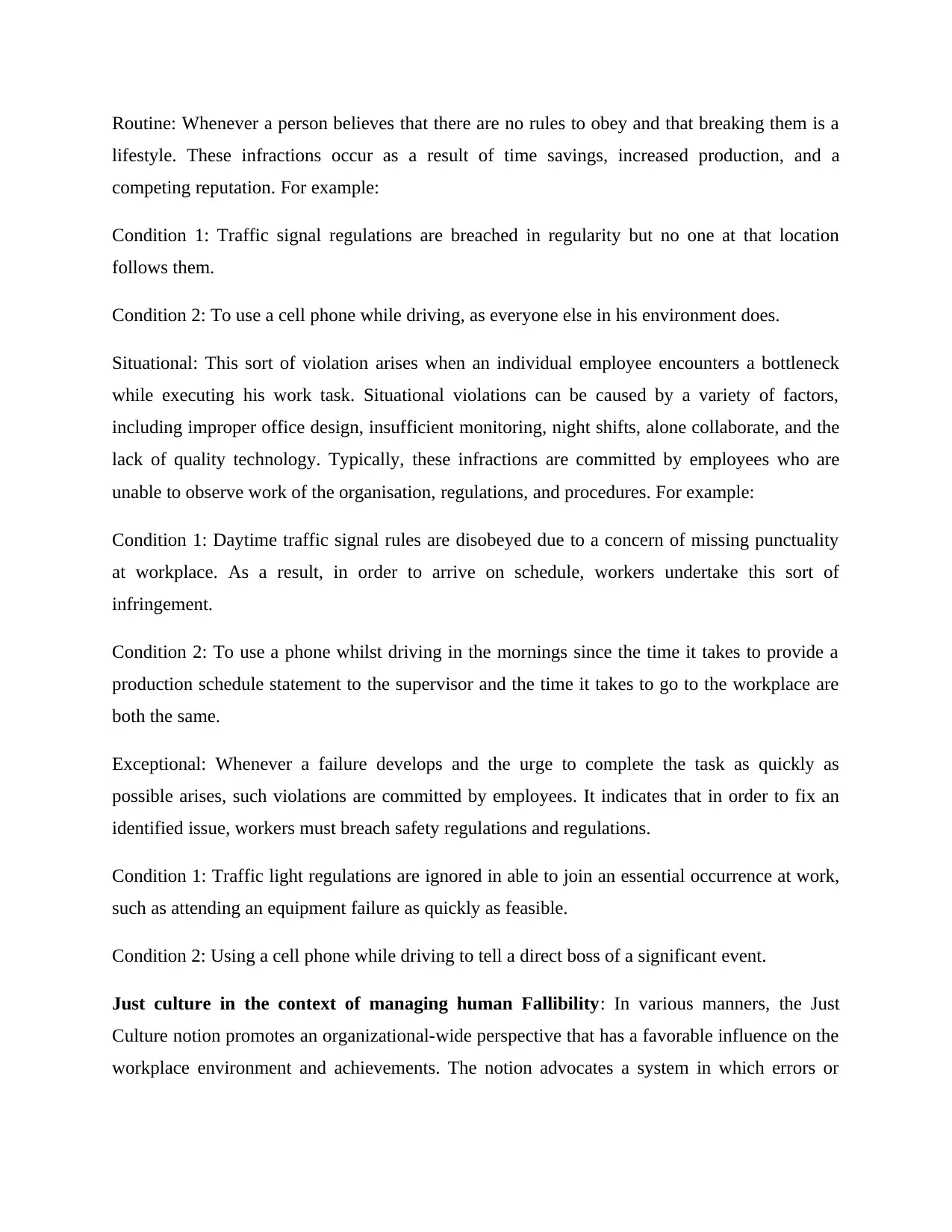
Routine: Whenever a person believes that there are no rules to obey and that breaking them is a
lifestyle. These infractions occur as a result of time savings, increased production, and a
competing reputation. For example:
Condition 1: Traffic signal regulations are breached in regularity but no one at that location
follows them.
Condition 2: To use a cell phone while driving, as everyone else in his environment does.
Situational: This sort of violation arises when an individual employee encounters a bottleneck
while executing his work task. Situational violations can be caused by a variety of factors,
including improper office design, insufficient monitoring, night shifts, alone collaborate, and the
lack of quality technology. Typically, these infractions are committed by employees who are
unable to observe work of the organisation, regulations, and procedures. For example:
Condition 1: Daytime traffic signal rules are disobeyed due to a concern of missing punctuality
at workplace. As a result, in order to arrive on schedule, workers undertake this sort of
infringement.
Condition 2: To use a phone whilst driving in the mornings since the time it takes to provide a
production schedule statement to the supervisor and the time it takes to go to the workplace are
both the same.
Exceptional: Whenever a failure develops and the urge to complete the task as quickly as
possible arises, such violations are committed by employees. It indicates that in order to fix an
identified issue, workers must breach safety regulations and regulations.
Condition 1: Traffic light regulations are ignored in able to join an essential occurrence at work,
such as attending an equipment failure as quickly as feasible.
Condition 2: Using a cell phone while driving to tell a direct boss of a significant event.
Just culture in the context of managing human Fallibility: In various manners, the Just
Culture notion promotes an organizational-wide perspective that has a favorable influence on the
workplace environment and achievements. The notion advocates a system in which errors or
lifestyle. These infractions occur as a result of time savings, increased production, and a
competing reputation. For example:
Condition 1: Traffic signal regulations are breached in regularity but no one at that location
follows them.
Condition 2: To use a cell phone while driving, as everyone else in his environment does.
Situational: This sort of violation arises when an individual employee encounters a bottleneck
while executing his work task. Situational violations can be caused by a variety of factors,
including improper office design, insufficient monitoring, night shifts, alone collaborate, and the
lack of quality technology. Typically, these infractions are committed by employees who are
unable to observe work of the organisation, regulations, and procedures. For example:
Condition 1: Daytime traffic signal rules are disobeyed due to a concern of missing punctuality
at workplace. As a result, in order to arrive on schedule, workers undertake this sort of
infringement.
Condition 2: To use a phone whilst driving in the mornings since the time it takes to provide a
production schedule statement to the supervisor and the time it takes to go to the workplace are
both the same.
Exceptional: Whenever a failure develops and the urge to complete the task as quickly as
possible arises, such violations are committed by employees. It indicates that in order to fix an
identified issue, workers must breach safety regulations and regulations.
Condition 1: Traffic light regulations are ignored in able to join an essential occurrence at work,
such as attending an equipment failure as quickly as feasible.
Condition 2: Using a cell phone while driving to tell a direct boss of a significant event.
Just culture in the context of managing human Fallibility: In various manners, the Just
Culture notion promotes an organizational-wide perspective that has a favorable influence on the
workplace environment and achievements. The notion advocates a system in which errors or
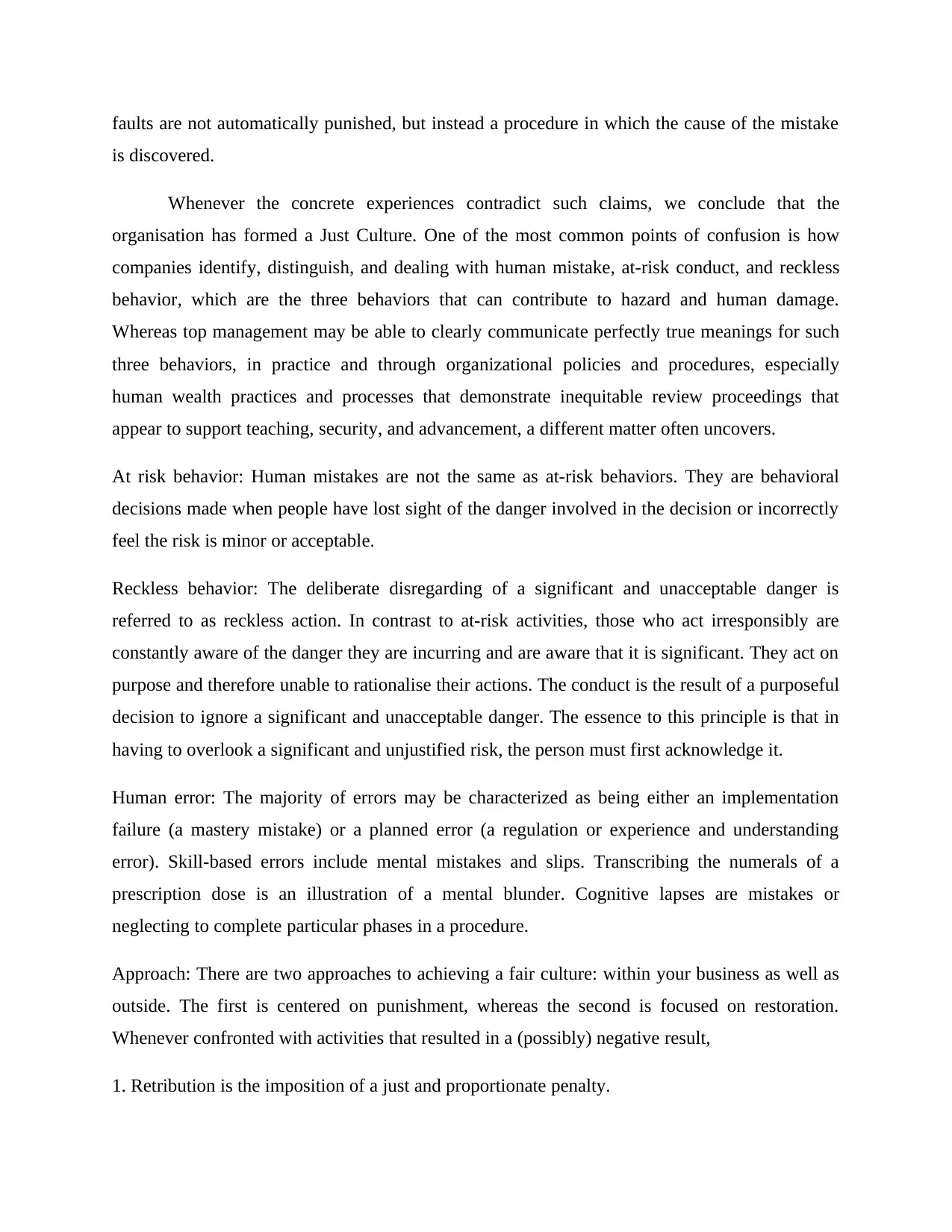
faults are not automatically punished, but instead a procedure in which the cause of the mistake
is discovered.
Whenever the concrete experiences contradict such claims, we conclude that the
organisation has formed a Just Culture. One of the most common points of confusion is how
companies identify, distinguish, and dealing with human mistake, at-risk conduct, and reckless
behavior, which are the three behaviors that can contribute to hazard and human damage.
Whereas top management may be able to clearly communicate perfectly true meanings for such
three behaviors, in practice and through organizational policies and procedures, especially
human wealth practices and processes that demonstrate inequitable review proceedings that
appear to support teaching, security, and advancement, a different matter often uncovers.
At risk behavior: Human mistakes are not the same as at-risk behaviors. They are behavioral
decisions made when people have lost sight of the danger involved in the decision or incorrectly
feel the risk is minor or acceptable.
Reckless behavior: The deliberate disregarding of a significant and unacceptable danger is
referred to as reckless action. In contrast to at-risk activities, those who act irresponsibly are
constantly aware of the danger they are incurring and are aware that it is significant. They act on
purpose and therefore unable to rationalise their actions. The conduct is the result of a purposeful
decision to ignore a significant and unacceptable danger. The essence to this principle is that in
having to overlook a significant and unjustified risk, the person must first acknowledge it.
Human error: The majority of errors may be characterized as being either an implementation
failure (a mastery mistake) or a planned error (a regulation or experience and understanding
error). Skill-based errors include mental mistakes and slips. Transcribing the numerals of a
prescription dose is an illustration of a mental blunder. Cognitive lapses are mistakes or
neglecting to complete particular phases in a procedure.
Approach: There are two approaches to achieving a fair culture: within your business as well as
outside. The first is centered on punishment, whereas the second is focused on restoration.
Whenever confronted with activities that resulted in a (possibly) negative result,
1. Retribution is the imposition of a just and proportionate penalty.
is discovered.
Whenever the concrete experiences contradict such claims, we conclude that the
organisation has formed a Just Culture. One of the most common points of confusion is how
companies identify, distinguish, and dealing with human mistake, at-risk conduct, and reckless
behavior, which are the three behaviors that can contribute to hazard and human damage.
Whereas top management may be able to clearly communicate perfectly true meanings for such
three behaviors, in practice and through organizational policies and procedures, especially
human wealth practices and processes that demonstrate inequitable review proceedings that
appear to support teaching, security, and advancement, a different matter often uncovers.
At risk behavior: Human mistakes are not the same as at-risk behaviors. They are behavioral
decisions made when people have lost sight of the danger involved in the decision or incorrectly
feel the risk is minor or acceptable.
Reckless behavior: The deliberate disregarding of a significant and unacceptable danger is
referred to as reckless action. In contrast to at-risk activities, those who act irresponsibly are
constantly aware of the danger they are incurring and are aware that it is significant. They act on
purpose and therefore unable to rationalise their actions. The conduct is the result of a purposeful
decision to ignore a significant and unacceptable danger. The essence to this principle is that in
having to overlook a significant and unjustified risk, the person must first acknowledge it.
Human error: The majority of errors may be characterized as being either an implementation
failure (a mastery mistake) or a planned error (a regulation or experience and understanding
error). Skill-based errors include mental mistakes and slips. Transcribing the numerals of a
prescription dose is an illustration of a mental blunder. Cognitive lapses are mistakes or
neglecting to complete particular phases in a procedure.
Approach: There are two approaches to achieving a fair culture: within your business as well as
outside. The first is centered on punishment, whereas the second is focused on restoration.
Whenever confronted with activities that resulted in a (possibly) negative result,
1. Retribution is the imposition of a just and proportionate penalty.
⊘ This is a preview!⊘
Do you want full access?
Subscribe today to unlock all pages.

Trusted by 1+ million students worldwide
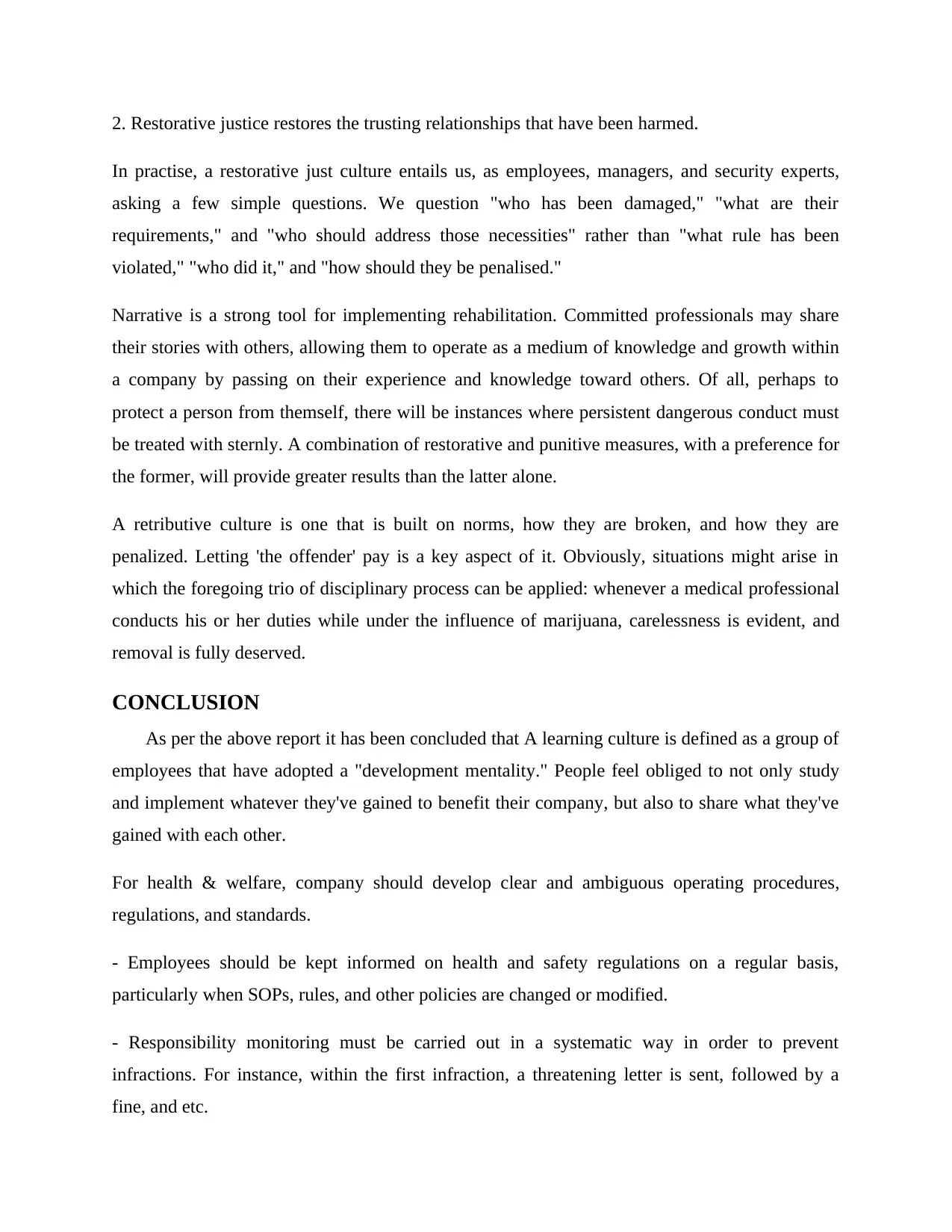
2. Restorative justice restores the trusting relationships that have been harmed.
In practise, a restorative just culture entails us, as employees, managers, and security experts,
asking a few simple questions. We question "who has been damaged," "what are their
requirements," and "who should address those necessities" rather than "what rule has been
violated," "who did it," and "how should they be penalised."
Narrative is a strong tool for implementing rehabilitation. Committed professionals may share
their stories with others, allowing them to operate as a medium of knowledge and growth within
a company by passing on their experience and knowledge toward others. Of all, perhaps to
protect a person from themself, there will be instances where persistent dangerous conduct must
be treated with sternly. A combination of restorative and punitive measures, with a preference for
the former, will provide greater results than the latter alone.
A retributive culture is one that is built on norms, how they are broken, and how they are
penalized. Letting 'the offender' pay is a key aspect of it. Obviously, situations might arise in
which the foregoing trio of disciplinary process can be applied: whenever a medical professional
conducts his or her duties while under the influence of marijuana, carelessness is evident, and
removal is fully deserved.
CONCLUSION
As per the above report it has been concluded that A learning culture is defined as a group of
employees that have adopted a "development mentality." People feel obliged to not only study
and implement whatever they've gained to benefit their company, but also to share what they've
gained with each other.
For health & welfare, company should develop clear and ambiguous operating procedures,
regulations, and standards.
- Employees should be kept informed on health and safety regulations on a regular basis,
particularly when SOPs, rules, and other policies are changed or modified.
- Responsibility monitoring must be carried out in a systematic way in order to prevent
infractions. For instance, within the first infraction, a threatening letter is sent, followed by a
fine, and etc.
In practise, a restorative just culture entails us, as employees, managers, and security experts,
asking a few simple questions. We question "who has been damaged," "what are their
requirements," and "who should address those necessities" rather than "what rule has been
violated," "who did it," and "how should they be penalised."
Narrative is a strong tool for implementing rehabilitation. Committed professionals may share
their stories with others, allowing them to operate as a medium of knowledge and growth within
a company by passing on their experience and knowledge toward others. Of all, perhaps to
protect a person from themself, there will be instances where persistent dangerous conduct must
be treated with sternly. A combination of restorative and punitive measures, with a preference for
the former, will provide greater results than the latter alone.
A retributive culture is one that is built on norms, how they are broken, and how they are
penalized. Letting 'the offender' pay is a key aspect of it. Obviously, situations might arise in
which the foregoing trio of disciplinary process can be applied: whenever a medical professional
conducts his or her duties while under the influence of marijuana, carelessness is evident, and
removal is fully deserved.
CONCLUSION
As per the above report it has been concluded that A learning culture is defined as a group of
employees that have adopted a "development mentality." People feel obliged to not only study
and implement whatever they've gained to benefit their company, but also to share what they've
gained with each other.
For health & welfare, company should develop clear and ambiguous operating procedures,
regulations, and standards.
- Employees should be kept informed on health and safety regulations on a regular basis,
particularly when SOPs, rules, and other policies are changed or modified.
- Responsibility monitoring must be carried out in a systematic way in order to prevent
infractions. For instance, within the first infraction, a threatening letter is sent, followed by a
fine, and etc.
Paraphrase This Document
Need a fresh take? Get an instant paraphrase of this document with our AI Paraphraser
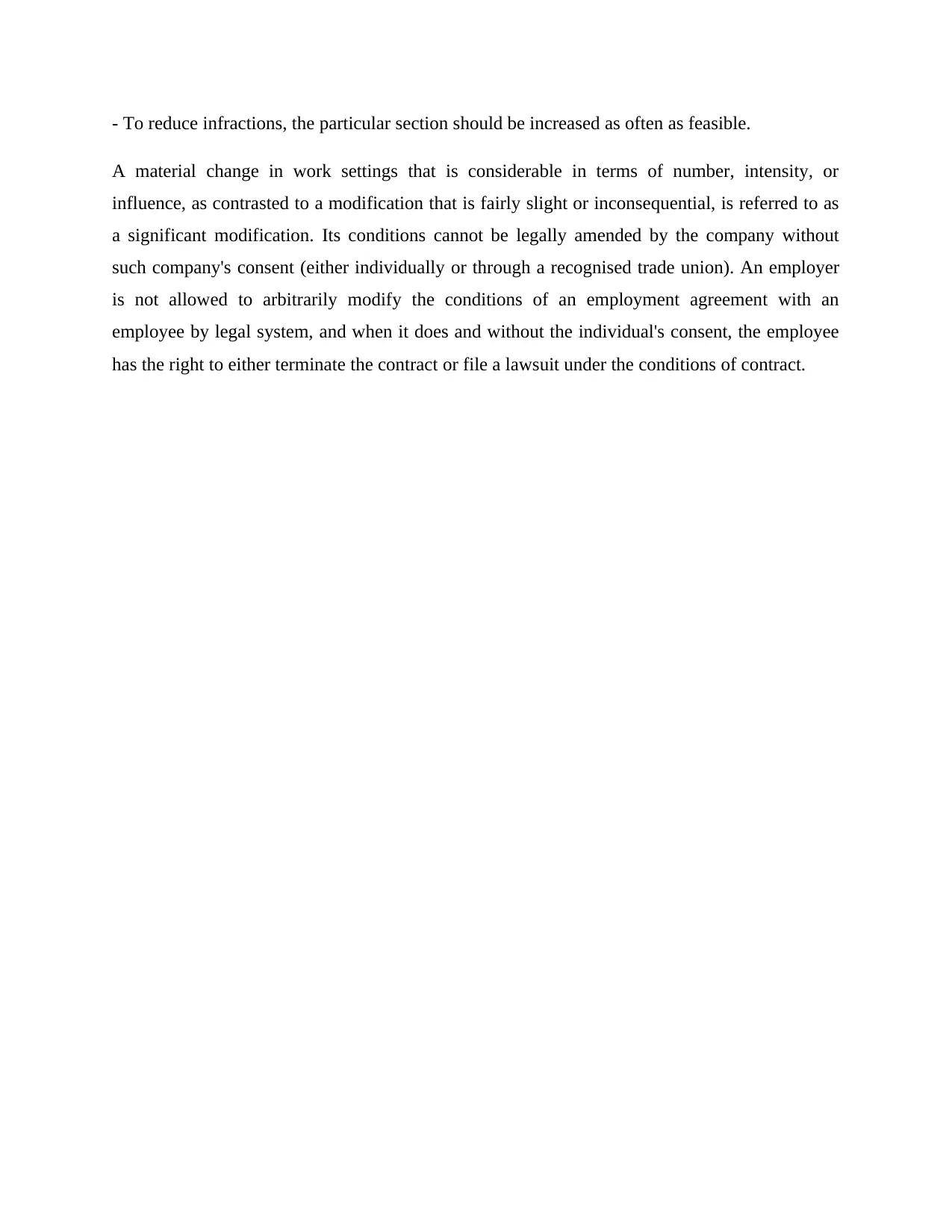
- To reduce infractions, the particular section should be increased as often as feasible.
A material change in work settings that is considerable in terms of number, intensity, or
influence, as contrasted to a modification that is fairly slight or inconsequential, is referred to as
a significant modification. Its conditions cannot be legally amended by the company without
such company's consent (either individually or through a recognised trade union). An employer
is not allowed to arbitrarily modify the conditions of an employment agreement with an
employee by legal system, and when it does and without the individual's consent, the employee
has the right to either terminate the contract or file a lawsuit under the conditions of contract.
A material change in work settings that is considerable in terms of number, intensity, or
influence, as contrasted to a modification that is fairly slight or inconsequential, is referred to as
a significant modification. Its conditions cannot be legally amended by the company without
such company's consent (either individually or through a recognised trade union). An employer
is not allowed to arbitrarily modify the conditions of an employment agreement with an
employee by legal system, and when it does and without the individual's consent, the employee
has the right to either terminate the contract or file a lawsuit under the conditions of contract.
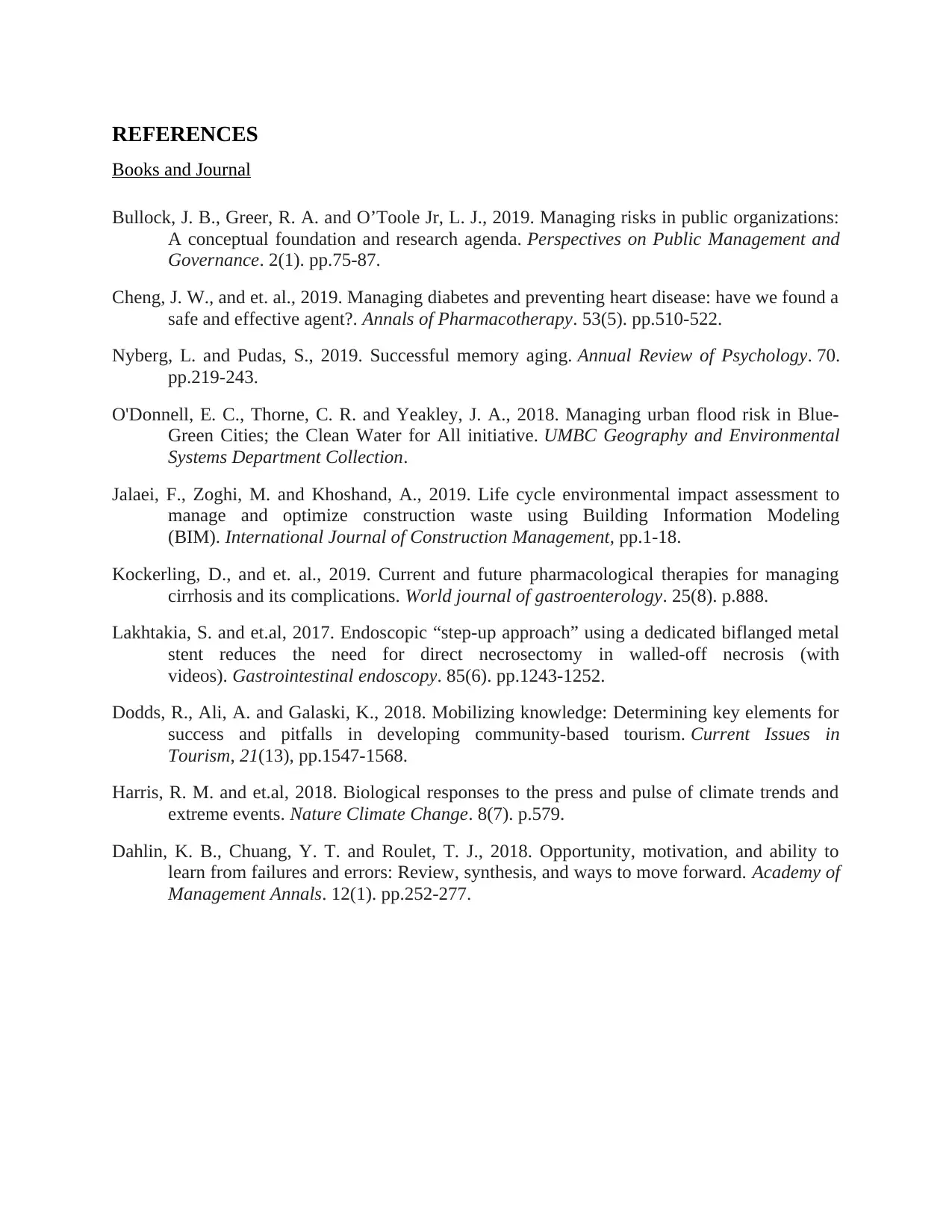
REFERENCES
Books and Journal
Bullock, J. B., Greer, R. A. and O’Toole Jr, L. J., 2019. Managing risks in public organizations:
A conceptual foundation and research agenda. Perspectives on Public Management and
Governance. 2(1). pp.75-87.
Cheng, J. W., and et. al., 2019. Managing diabetes and preventing heart disease: have we found a
safe and effective agent?. Annals of Pharmacotherapy. 53(5). pp.510-522.
Nyberg, L. and Pudas, S., 2019. Successful memory aging. Annual Review of Psychology. 70.
pp.219-243.
O'Donnell, E. C., Thorne, C. R. and Yeakley, J. A., 2018. Managing urban flood risk in Blue-
Green Cities; the Clean Water for All initiative. UMBC Geography and Environmental
Systems Department Collection.
Jalaei, F., Zoghi, M. and Khoshand, A., 2019. Life cycle environmental impact assessment to
manage and optimize construction waste using Building Information Modeling
(BIM). International Journal of Construction Management, pp.1-18.
Kockerling, D., and et. al., 2019. Current and future pharmacological therapies for managing
cirrhosis and its complications. World journal of gastroenterology. 25(8). p.888.
Lakhtakia, S. and et.al, 2017. Endoscopic “step-up approach” using a dedicated biflanged metal
stent reduces the need for direct necrosectomy in walled-off necrosis (with
videos). Gastrointestinal endoscopy. 85(6). pp.1243-1252.
Dodds, R., Ali, A. and Galaski, K., 2018. Mobilizing knowledge: Determining key elements for
success and pitfalls in developing community-based tourism. Current Issues in
Tourism, 21(13), pp.1547-1568.
Harris, R. M. and et.al, 2018. Biological responses to the press and pulse of climate trends and
extreme events. Nature Climate Change. 8(7). p.579.
Dahlin, K. B., Chuang, Y. T. and Roulet, T. J., 2018. Opportunity, motivation, and ability to
learn from failures and errors: Review, synthesis, and ways to move forward. Academy of
Management Annals. 12(1). pp.252-277.
Books and Journal
Bullock, J. B., Greer, R. A. and O’Toole Jr, L. J., 2019. Managing risks in public organizations:
A conceptual foundation and research agenda. Perspectives on Public Management and
Governance. 2(1). pp.75-87.
Cheng, J. W., and et. al., 2019. Managing diabetes and preventing heart disease: have we found a
safe and effective agent?. Annals of Pharmacotherapy. 53(5). pp.510-522.
Nyberg, L. and Pudas, S., 2019. Successful memory aging. Annual Review of Psychology. 70.
pp.219-243.
O'Donnell, E. C., Thorne, C. R. and Yeakley, J. A., 2018. Managing urban flood risk in Blue-
Green Cities; the Clean Water for All initiative. UMBC Geography and Environmental
Systems Department Collection.
Jalaei, F., Zoghi, M. and Khoshand, A., 2019. Life cycle environmental impact assessment to
manage and optimize construction waste using Building Information Modeling
(BIM). International Journal of Construction Management, pp.1-18.
Kockerling, D., and et. al., 2019. Current and future pharmacological therapies for managing
cirrhosis and its complications. World journal of gastroenterology. 25(8). p.888.
Lakhtakia, S. and et.al, 2017. Endoscopic “step-up approach” using a dedicated biflanged metal
stent reduces the need for direct necrosectomy in walled-off necrosis (with
videos). Gastrointestinal endoscopy. 85(6). pp.1243-1252.
Dodds, R., Ali, A. and Galaski, K., 2018. Mobilizing knowledge: Determining key elements for
success and pitfalls in developing community-based tourism. Current Issues in
Tourism, 21(13), pp.1547-1568.
Harris, R. M. and et.al, 2018. Biological responses to the press and pulse of climate trends and
extreme events. Nature Climate Change. 8(7). p.579.
Dahlin, K. B., Chuang, Y. T. and Roulet, T. J., 2018. Opportunity, motivation, and ability to
learn from failures and errors: Review, synthesis, and ways to move forward. Academy of
Management Annals. 12(1). pp.252-277.
⊘ This is a preview!⊘
Do you want full access?
Subscribe today to unlock all pages.

Trusted by 1+ million students worldwide

1 out of 10
Related Documents
Your All-in-One AI-Powered Toolkit for Academic Success.
+13062052269
info@desklib.com
Available 24*7 on WhatsApp / Email
![[object Object]](/_next/static/media/star-bottom.7253800d.svg)
Unlock your academic potential
Copyright © 2020–2025 A2Z Services. All Rights Reserved. Developed and managed by ZUCOL.





